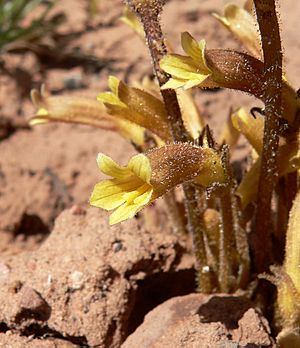Clustered broomrape facts for kids
Quick facts for kids Clustered broomrape |
|
|---|---|
 |
|
| Conservation status | |
| Scientific classification | |
| Genus: |
Orobanche
|
| Species: |
fasciculata
|
| Synonyms | |
|
Anoplanthus fasciculatus |
|
Orobanche fasciculata is a unique plant often called clustered broomrape. You can find this plant in many parts of western and central North America. It grows from Alaska all the way down to northern Mexico. It also grows near the Great Lakes. This plant can live in many different natural places.
This plant is a parasite. This means it attaches to the roots of other plants. It gets its food from them. It often uses plants like Artemisia, Eriodictyon, and Eriogonum as hosts.
What is Clustered Broomrape?
Clustered broomrape grows stems from a thick root. These stems can stand up straight. They can reach about 20 centimeters (8 inches) tall. Since it gets food from other plants, it does not need leaves. It also does not have chlorophyll. Chlorophyll is what makes most plants green.
Colors and Flowers
The clustered broomrape can be different colors. It is often yellowish or purple. Its flowers grow in a group called an inflorescence. This group can have up to 20 flowers. Each flower grows on its own stem, called a pedicel. These small stems can be up to 15 centimeters (6 inches) long.
Each flower has special parts. It has a calyx made of hairy, triangle-shaped sepals. It also has a tube-shaped corolla. This corolla is about 1.5 to 3 centimeters (0.6 to 1.2 inches) long. The flowers are usually yellowish or purplish.


